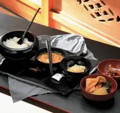Komego - Miso that 778-year-old Zen Temple selected
Miso is a typical seasoning that has been loved in Japan for centuries. In this issue, we will introduce "Komego" miso, which continues to preserve its 778-year-old taste and production method.
The origin of miso making
Komego started making miso in Tenpo 2*(1831) in the castle town of Fukui, and has been building on its tradition ever since. Despite its factory being destroyed by earthquakes and burning down during the war, Komego overcome each setback to enhance its heritage each time.
This is built on solid craftsmanship and the best environment for developing the natural yeast and bacteria needed for world class miso. In 1970, Komego was chosen as the sole miso manufacturer for the celebrations of the 778 year history of the Eihei-ji Zen Buddhist temple.
*A Japanese era name is a title used for numbering years in the Japanese calendar system.


The main Temple of a Buddhist sect of the Sōtō, "Eihei-ji"
Eihei-ji is one of two main temples of the Sōtō school of Zen Buddhism founded by Eihei Dogen in Fukui in 1244 and the largest single religious denomination in Japan. Dogen wrote the book "Tenzo Kyoken" which taught that everyday cooking is an integral part of Buddhist training.
'Tenzo' is the title given to the chef at a Buddhist monastery. 'Kyokun' means 'rules' or 'lesson'. Since the temple’s founding, all meals served in Eihei-ji to all visitors and initiates have been based on the traditional recipes and spirit of "Tenzo Kyoken". This culinary heritage is 'Shojin cuisine', which is primarily based on vegetables and fruit. Miso was the major source of protein and salt for the trainee monks after their rigorous training especially during harsh winter days.
Harmony of three ingredients, 'salt', 'soy bean' and 'malted rice'
Komego only uses three ingredients for its miso: salt: soy beans: and malted rice. There are no preservatives or additives. This is why it does not compromise on ingredients, which all come from Japan.
The company regularly visits the farmers and producers of its ingredients to ensure they maintain the quality required. As the sole producer of Eihei-ji's miso, Komego:s mission is to guarantee you also enjoy this long, rich history and taste through its "Kura" miso series.
Yeast Bacteria lives in Komego
"Kura" means storage for precious things in Japanese. Miso manufacturers sometimes call themselves miso-gura. Traditionally, it is said that old kura has its own unique character called "Kura-guse", which is carefully managed by craftsmen. Komego uses a natural ageing process, managing the temperature, humidity and other conditions that have a big impact on the fermentation process. Komego intends to pass its traditional Japanese miso to future generations.
Yappun is honored and fortunate as a importer to deliver such a traditional Japanese miso to Hong Kong.

Variety of Miso
There are two types of miso: "Grain" and "Ground”. Each has different textures and uses.
Grain

Ground










